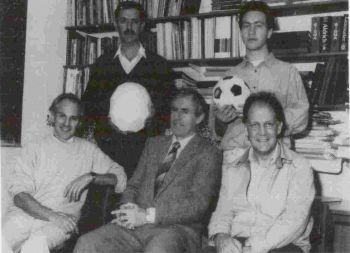This week in 1990 – Scientists produce pure samples of Buckyballs
By: James Hakner
Last updated: Thursday, 27 October 2011

Sussex scientists celebrate producing pure samples of Buckyballs in 1990. From left, seated: Harry Kroto, Roger Taylor and David Walton; and, standing, Ala's Abdul-Sada and Jonathan Hare
This week in 1990, Sussex scientists, including Professor Harry Kroto, produced pure samples of the third form of carbon C60 Buckminsterfullerene (known as Buckyballs).
This "major breakthrough in carbon chemistry" came five years after the football-shaped molecules were first discovered, by the Sussex team.
Professor Kroto would later (in 1996) be awarded the Nobel Prize for Chemistry for this work.
Here is an extract from the original article in the Bulletin published 30 October 1990:
Major breakthrough in carbon chemistry
Recent discoveries made at Sussex have opened up a whole new area of Carbon Chemistry.
Members of the School of Chemistry and Molecular Sciences have achieved a major breakthrough by producing pure samples of the third form of carbon - C60 Buckminsterfullerene.
Diamond and graphite are the two well-known forms of carbon and, until recently, it was considered most unlikely that a third, highly stable form of the element might exist. The new achievement confirms conclusions drawn from some earlier joint Sussex-Texas discoveries which suggested that this molecule plays a shadowy, but important, role in chemistry...
You can also discuss this article on the 50th anniversary Facebook page or on Twitter (#SussexUni50).

